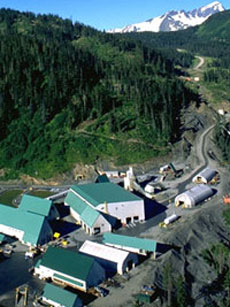
[Second of a two-part series. Read the first part here.]
The Tahltan elders who took over their band's Telegraph Creek administration building more than a month ago have promised to stay put until their elected chief resigns.
"Jerry Asp has lost all credibility," said the elders—women and men between the ages of 55 and 84—in a February 17 statement. "He is far too cozy with industry and government, and poses a threat to our very existence."
The elders allege Asp acted beyond his authority when he and the Tahltan Tribal Council signed a $250,000-a-year deal with the province "to provide certainty for resource development" in their traditional territories. And they say Asp—who is addition to being Chief of the Telegraph Creek band, is also Chief Operating Officer of the Tahltan Nation Development Corporation—is caught in too powerful a conflict of interest to act in their best interest. They elders fear that deal would empower Gordon Campbell's Liberals to fast-track several mines, a gas field, a hydroelectric dam and possibly a controversial road to the Alaskan coast.
First Nations artist Dempsey Bob is one of several Tahltan and Tlingit who have joined the occupation since January 17. "We have to protect our animals and fish," he said. "We can't eat oil, gas and minerals."
Both Chief, and Chief Operating Officer Jerry Asp was elected to head the Tahltan Nation's largest band in 2003 and 2004. He was among the first chiefs elected after the Supreme Court of Canada's Corbiere decision took effect. In order to force bands into compliance with the Canadian Charter of Rights and Freedoms, Corbiere requires bands to allow all members to vote in Indian Act elections—not only those who live on reserve, as had been the practice.
There are an estimated 5,000 Tahltan living throughout Canada, but only about 1,500 live on the eleven reserves in northern B.C. Reserves near Telegraph Creek, Dease Lake and Iskut serve as community centers.
Oscar Dennis, a university educated Tahltan who is serving as a spokesman for the elders, said that fewer than 400 Tahltan voted in the last election. Dennis said the small number of participants is evidence of Asp's lack of widespread support within the Tahltan nation. "He got in to office through the support of his own family," Dennis said, "and others who work for his Tahltan Nation Development Corporation."
Asp founded the Tahltan Nation Development Corporation (TNDC) in 1985. The company's shareholders include the Tahltan and Iskut bands. Asp served as president and chief executive officer until 1993, and remains TNDC's chief operating officer. TNDC has cleared roads into remote mines, built mining operation sites and performed open-pit mining. According to its own promotional releases, the company is the largest Native-owned and operated heavy construction company in Western Canada.
At Barrick Gold Corporation's Eskay Creek mine, for example, TNDC has a life-of-mine contract to provide road construction, maintenance and snow-clearing services. A TNDC subsidiary also reportedly provides housekeeping and catering services to the fly-in mine, which is among the highest grade gold and silver mines in the world. Likewise, TNDC also has a deal to provide construction and roadwork to Shell Canada, one of the other companies promised "certainty" under the controversial 2004 agreement. Last summer, Shell began drilling into coalfields that partly underlie the Spatsizi Plateau Wilderness Park. Shell plans to force methane gas from the coalfield by pumping massive volumes of water underground. Shell's ambitious Mount Klappan project represents an estimated 9 per cent of B.C.'s coalbed methane potential.
The Tahltan elders alleged these sorts of deals put Asp in a conflict of interest. Said Dennis: "All the decisions he's making on behalf of the Tahltan conveniently serve the interests of his company."
Asp declined to talk to The Tyee for this article. (He hung up the phone after saying only: "I'm not interested in talking to you."
Asp talks frequently to pro-mining groups, however. He is vice-president of Canadian Aboriginal Minerals Association—a group he helped create—and uses this platform to talk about the jobs he's created. For example, he talked to a 2004 Manitoba mining conference about the Eskay Creek mine, where more than 34 per cent of the 320 on-site workers are native. Asp reportedly said, "The Tahltans view this relationship as a win-win situation for both the mining company, Barrick Gold Corporation, and the Tahltans."
Asp also spoke to freelance journalist Shirley Collingridge, who has posted a profile of the Chief on her promotional web site. In Vini Vidi Vici: Tahltan Chief Conquers Mining Industry, Collingridge wrote:
"Overall, says Asp, the mining experience has been a very positive experience for him. Besides successfully championing Aboriginal issues, Asp has 'traveled all over the world on somebody else's nickel. They are calling me every week to go somewhere.' In the past three years alone, Asp has been once to Australia, twice to the U.K., and three times to South America. … 'Canada is considered the foremost expert in Aboriginal mining relations today,' says Asp. 'That's why CAMA [the Canadian Aboriginal Minerals Association] is invited around the world.'"
To tunnel toward Alaska
Tahltan Nation Development Corporation has also worked for NovaGold Resources, which is considering construction of an open pit mine on 104,735 acres west of the Stikine River. NovaGold's Galore Creek project was the subject of several presentations at the Dease Lake assembly that triggered the elders' protest. Later this year, NovaGold plans to release a prefeasibility study for what the company describes as one of the largest undeveloped resources in North America.
Should TNDC obtain a road construction contract for the NovaGold mine—as it has for several similar projects—the non-union firm could wind up involved in its most ambitions construction project yet: tunneling under a glacier. NovaGold studied several options for an access road to the Galore Creek site, and presented an overview of its two preferred routes at the Dease Lake assembly. Both routes involve tunneling under ice, one for two kilometers and the other for as much as 14 kilometers through glacier-capped-limestone.
The gated road proposed by NovaGold would be a controlled-access corridor open only to mine vehicles bearing special use permits from the province. But due to the location of the Galore Creek mine, the road would inevitably lead from Hwy. 37 to the Alaska coast, along a highway route akin to one that Alaskan politicians have spent 20 years trying to develop.
U.S. efforts to link the landlocked Alaska "panhandle" with the continental highway system have escalated in recent years, as the state's Republican congressional delegation found a ready ear in the Bush White House. Prior to news of the NovaGold project, their favored route had been to extend the TNDC-built access road to the Eskay Creek mine to the Bradfield Canal, meeting the fjord in the shadow of Tyee Mountain and continuing at sea level to a new deep water port and ferry terminal near Wrangell.
The Galore Creek road would present the Alaska delegation with an alternative route. And if TNDC or some other company were to complete the tunneling under the less-rigid permitting process of a limited-use road, the conversion of that route to a public road at a later date would face less environmental scrutiny—since most of any damage would have already been done.
Studies conducted on both sides of the border have concluded that such a road would reward Alaska's economy at the expense of British Columbia, as Canadian resources flow overseas through U.S. ports.
Galore Creek General Manager Carl Gagnier told The Tyee that NovaGold had no intention for its mining road to become part of the so-called Bradfield Road. "No. We've never seriously looked at that," he said. "That's somebody's idea to develop something in Alaska."
NovaGold's two other major projects are in the Alaskan interior. Its massive Donlin Creek effort is a joint venture with Placer Dome, and its and Ambler Project is a joint venture with Rio Tinto. Galore Creek, in fact, is the southernmost project listed on NovaGold's web site. Given that permitting those Alaskan projects is crucial to the fast-growing company's success, it's reasonable to assume that NovaGold has some degree of contact with Alaskan political leaders who also back the Bradfield road.
Elders promise to remain
Nancy McGee is one of the Tahltan elders participating in the Telegraph Creek protest. The proposed roads would traverse her family's traditional trapping territory. After NovaGold presented its road-building options at the Deese Lake assembly, she reportedly pointed a finger at the NovaGold spokesman and said, "You're gonna' shit on our land."
"In the past, a leader was watched from the time they were little," said elder Henry Quock, who likes to tell stories and tease others at the sit-in. "The elders chose a leader based solely on his ability to be honest."
The elders promise to continue their occupation until Asp resigns and the 2004 "certainty" agreement is overturned.
Asp has obtained a court order to have them forcibly removed, but had not yet executed that order as this article went to press. "The use of courts and laws to repress those without the financial means to employ legal representation is well-known. However, for an Aboriginal person to do the same in shameful," the elders replied. "Asp is prepared to repress the dissenting voices in order to maintain a strangle hold on his people."
To read the first part of this two-part series, go here.
Monte Paulsen is a contributing editor at Vancouver's Shared Vision magazine.
![]()















Tyee Commenting Guidelines
Comments that violate guidelines risk being deleted, and violations may result in a temporary or permanent user ban. Maintain the spirit of good conversation to stay in the discussion.
*Please note The Tyee is not a forum for spreading misinformation about COVID-19, denying its existence or minimizing its risk to public health.
Do:
Do not: